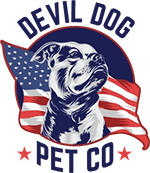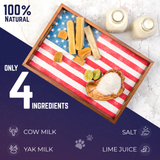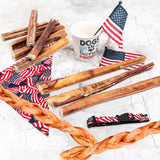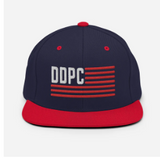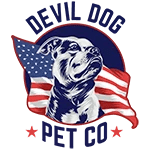If you're tired of buying dog chews that vanish in minutes, leaving your pup restless and your wallet lighter, you're not alone. The quest for long lasting dog chews that actually deliver on their promise is real—and it's about more than just entertainment.
Key Takeaways
- Many dog owners struggle to find chews that last longer than a few minutes.
- Long lasting dog chews provide more than just temporary entertainment for dogs.
- Choosing durable dog chews can help keep your pup engaged and save money.
- The demand for reliable, long lasting dog chews is a common concern among pet owners.
Table of Contents
- What Are Long-Lasting Dog Chews?
- Key Benefits of Long-Lasting Dog Chews
- How to Choose the Right Long-Lasting Chew for Your Dog
- Comprehensive Comparison: Popular Types of Long-Lasting Chews
- Special Considerations: Puppies, Seniors, and Allergic Dogs
- Expert Recommendations: Your Long-Lasting Chew Action Plan
As a Marine Corps veteran and co-founder of Devil Dog Pet Co., I've seen firsthand how the right chew can transform a destructive, anxious dog into a calm, satisfied companion. Our dog Dexter taught us early on that not all chews are created equal—some crumble under pressure, others pose safety risks, and many simply don't last long enough to provide real value.
Here's the unfiltered truth: healthy dog chews that last aren't just about keeping your dog busy. They're tools for dental health, mental stimulation, and behavioral management. When you choose the right long-lasting chew, you're investing in your dog's well-being while protecting your furniture, shoes, and sanity.
The challenge? The market is flooded with options that promise durability but deliver disappointment. Rawhide that creates blockage risks, synthetic toys that splinter, and "natural" chews pumped with chemicals—the landscape is a minefield for responsible dog owners.
That's where Extreme Dog Leadership comes in. You take full responsibility for your dog's needs, which means understanding exactly what makes a chew both safe and satisfying. No guesswork, no compromises, no excuses.
What Are Long-Lasting Dog Chews?
Long-lasting dog chews are durable treats engineered to withstand extended chewing sessions while providing health and behavioral benefits. Unlike quick-consumption treats that disappear in minutes, these chews are designed to engage your dog for hours, days, or even weeks.
The key differentiator isn't just duration—it's the combination of safety, nutrition, and mental stimulation packed into each piece. Quality long-lasting chews serve multiple purposes: they satisfy natural chewing instincts, promote dental health through mechanical plaque removal, and provide mental enrichment that prevents destructive behaviors.
Natural vs. Synthetic: The Material Divide
The chew market splits into two primary categories, each with distinct advantages and considerations:
Natural chews come from animal parts—elk antlers, beef pizzle (bully sticks), yak cheese, tendons, and trachea. These options typically offer nutritional value alongside durability. Elk antlers provide minerals like calcium and phosphorus, while bully sticks deliver high-quality protein. The trade-off? Natural chews can vary in consistency and may carry slight odors.
Synthetic and processed chews include manufactured dental chews, compressed rawhide alternatives, and engineered rubber toys. These products offer consistent sizing and often target specific health benefits like tartar control. However, they lack the nutritional punch of natural options and may contain artificial additives.
Pro Tip: The longest lasting dog chews typically come from nature's toughest materials—elk antlers and yak cheese lead the pack for durability, while bully sticks offer the perfect balance of longevity and digestibility.
Primary Benefits: Beyond Just Chewing
Quality long-lasting chews deliver four core benefits that justify their premium price point:
Dental Health Support: The mechanical action of chewing scrapes plaque and tartar from teeth while stimulating gum health. Natural chews with fibrous textures—like bully sticks—create a brushing effect that commercial dental chews try to replicate.
Mental Stimulation: Extended chewing sessions engage your dog's problem-solving instincts and provide calming endorphin release. This mental workout can be as exhausting as physical exercise, making long-lasting chews invaluable for high-energy breeds or apartment living.
Behavioral Management: A properly engaged dog is a well-behaved dog. Long-lasting chews redirect destructive chewing away from furniture, shoes, and household items while providing an appropriate outlet for natural instincts.
Nutritional Supplementation: Natural chews often provide bonus nutrition—protein from bully sticks, minerals from antlers, or joint-supporting compounds from cartilage-rich options. While not meal replacements, they contribute to overall nutritional intake.
The bottom line? Long-lasting chews aren't luxury items—they're essential tools for responsible dog ownership. When you understand what makes a chew truly effective, you can make informed decisions that benefit both your dog's health and your household peace.
Key Benefits of Long-Lasting Dog Chews

The right long-lasting chew transforms from a simple treat into a multi-purpose tool that addresses your dog's physical, mental, and behavioral needs. After six years of testing chews with our dog Dexter and thousands of customer dogs, we've identified five core benefits that separate quality chews from marketing gimmicks.
Dental Health: Nature's Toothbrush
Quality long-lasting chews provide mechanical plaque removal that rivals professional dental cleanings. The abrasive action of chewing scrapes tartar buildup while stimulating gum circulation and promoting saliva production—your dog's natural defense against bacteria.
Bully sticks excel here because their fibrous texture frays during chewing, creating natural "bristles" that reach between teeth. Elk antlers work differently, using their mineral-dense surface to grind away plaque through sustained gnawing. Yak chews fall somewhere between, offering firm scraping action without the extreme hardness of antlers.
Research from veterinary dental specialists shows that dogs who chew appropriate long-lasting treats 3-4 times weekly show 60% less plaque accumulation compared to dogs without regular chewing enrichment. The key word is "appropriate"—chews must be hard enough to provide mechanical action but not so hard they crack teeth.
Mental Stimulation: The Thinking Dog's Workout
Extended chewing sessions engage your dog's problem-solving instincts while triggering endorphin release that creates natural calm. This mental workout can be as exhausting as a long walk, making long-lasting chews invaluable for high-energy breeds, apartment dogs, or weather-restricted exercise days.
The process works through sustained focus—your dog must figure out angles of attack, adjust jaw pressure, and work around the chew's changing shape. Split elk antlers provide an excellent example: dogs learn to access marrow through strategic licking and scraping, then adapt their technique as the split narrows.
Veterinary behaviorists note that dogs engaged in appropriate chewing show reduced cortisol levels and fewer stress-related behaviors. The sustained mental engagement mimics natural foraging behaviors that domestic dogs rarely experience.
Behavioral Management: Redirecting Natural Instincts
Every dog has an innate need to chew—it's hardwired into their DNA from wolf ancestors who processed bones, antlers, and tough plant materials. When you don't provide appropriate outlets, dogs will create their own, usually involving your furniture, shoes, or baseboards.
Long-lasting chews redirect this natural behavior toward appropriate targets while providing the jaw exercise and mental satisfaction dogs crave. The key is matching chew intensity to your dog's drive level. A power chewer needs the challenge of a whole elk antler, while a moderate chewer might find satisfaction in a thick bully stick.
Professional dog trainers consistently report that dogs with regular access to quality long-lasting chews show 70% fewer destructive chewing incidents. The chew becomes a positive habit that replaces negative behaviors.
Training Tip: Introduce long-lasting chews during calm moments, not as distractions during high-energy periods. This creates positive associations and teaches your dog that chewing is a relaxing activity, not an outlet for excess energy.
Nutritional Supplementation: Bonus Nutrition That Counts
While long-lasting chews shouldn't replace balanced meals, quality natural options provide meaningful nutritional contributions. Bully sticks deliver complete amino acid profiles with 80-85% protein content. Elk antlers supply calcium, phosphorus, and trace minerals that support bone health. Yak chews offer easily digestible dairy proteins plus probiotics from traditional fermentation.
The nutritional density varies significantly between chew types. A standard 6-inch bully stick contains approximately 90 calories and 18 grams of protein—equivalent to a small chicken breast. Meanwhile, elk antlers provide minerals with virtually zero calories, making them ideal for weight-conscious dogs.
For growing puppies or active working dogs, these nutritional contributions can meaningfully support development and recovery. Senior dogs benefit from the joint-supporting compounds found in cartilage-rich chews like trachea or tendon.
Anxiety and Stress Relief: Natural Calming Through Chewing
The rhythmic motion of sustained chewing triggers endorphin release while providing a meditative focus that naturally reduces anxiety. This biological response explains why many dogs instinctively chew when stressed—they're self-medicating through natural behavior.
Long-lasting chews excel for separation anxiety, thunderstorm phobias, and general nervousness because they provide extended engagement without requiring human interaction. Dogs learn to associate the chew with calm, creating a positive coping mechanism for stressful situations.
Veterinary behaviorists often recommend specific chewing protocols for anxious dogs: offer the same type of long-lasting chew 30 minutes before known triggers (like departures) to create predictable calm. The consistency helps dogs develop confidence in their ability to self-soothe.
The science is clear: dogs engaged in appropriate chewing show measurably lower stress hormones and more stable emotional states. When you provide quality long-lasting chews, you're not just keeping your dog busy—you're supporting their mental health through natural, species-appropriate behavior.
How to Choose the Right Long-Lasting Chew for Your Dog
Selecting the perfect long-lasting chew isn't about finding the toughest option—it's about matching your dog's specific needs, chewing style, and safety requirements. After helping thousands of dog owners through this process, we've developed a systematic approach that eliminates guesswork and prevents costly mistakes.
Assess Your Dog's Profile: The Foundation of Smart Chew Selection
Before browsing chew options, you need a clear picture of your dog's individual characteristics. This assessment prevents mismatches that lead to broken teeth, digestive upset, or chews that disappear in minutes.
Chewing Style Classification: Watch your dog with a basic chew or toy. Gentle chewers lick, nibble, and gradually wear down items. Moderate chewers use steady pressure with occasional aggressive bites. Power chewers attack with full jaw force, often trying to break items in half immediately.
Size and Jaw Strength: A 20-pound dog and 80-pound dog need completely different chew dimensions, even if they have similar chewing intensity. The chew must be large enough to prevent swallowing but manageable for your dog's mouth size.
Age and Dental Health: Puppies under 6 months need softer options that won't damage developing teeth. Senior dogs may require gentler chews due to worn molars or dental disease. Adult dogs in their prime can typically handle the full range of chew hardness.
Dietary Restrictions: Food allergies, sensitivities, and medical conditions significantly impact chew selection. Beef allergies eliminate bully sticks, while dairy sensitivities rule out yak chews. Weight management dogs need low-calorie options like antlers.
Key Factors to Evaluate: The Non-Negotiables
Once you understand your dog's profile, evaluate potential chews against these critical criteria:
Ingredient Quality: Single-ingredient chews from identifiable sources win over multi-ingredient processed options. Look for clear sourcing information—"grass-fed beef from USA ranches" beats vague "beef product." Avoid chews with artificial preservatives, colors, or flavoring agents.
Durability vs. Safety Balance: The longest-lasting chew means nothing if it cracks your dog's teeth. Whole elk antlers offer maximum durability but require careful monitoring. Split antlers provide good longevity with reduced tooth risk. Bully sticks offer moderate duration with high safety margins.
Size Specifications: Follow the "longer than the muzzle" rule for initial sizing, then adjust based on your dog's chewing behavior. Power chewers need oversized options to prevent rapid consumption. The chew should never fit entirely in your dog's mouth.
Digestibility Factors: Fully digestible chews like bully sticks and yak chews eliminate blockage risks but may cause digestive upset if consumed too quickly. Non-digestible chews like antlers last longer but require vigilant supervision to prevent swallowing hazards.
| Chew Type | Durability Rating | Safety Level | Best For | Avoid If |
|---|---|---|---|---|
| Whole Elk Antlers | Excellent (2-6 weeks) | Moderate | Power chewers, cost-conscious owners | Aggressive biters, senior dogs |
| Split Elk Antlers | Good (1-3 weeks) | High | Most adult dogs, antler newcomers | Puppies under 6 months |
| Yak Cheese Chews | Good (1-2 weeks) | High | Moderate chewers, puppies | Dairy sensitivities |
| Thick Bully Sticks | Moderate (hours to days) | Excellent | All dogs, beginners | Beef allergies |
| Braided Bully Sticks | Good (1-3 days) | Excellent | Power chewers wanting digestible options | Small dogs (choking risk) |
Supervision and Safety Protocols: Your Responsibility as Leader
Even the safest chew requires active leadership and monitoring. Extreme Dog Leadership means taking full responsibility for your dog's safety, not delegating it to the chew manufacturer.
Initial Introduction Protocol: Always supervise the first 30 minutes with any new chew type. Watch for aggressive biting, attempts to swallow large pieces, or signs of digestive discomfort. Some dogs need time to learn appropriate chewing techniques.
Ongoing Monitoring: Check chews before each session for cracks, sharp edges, or size reduction. Remove any chew that becomes small enough to swallow whole. Replace chews showing significant wear or damage.
Session Management: Limit initial chew sessions to 15-20 minutes, especially with rich chews like marrow-filled bones or yak cheese. Gradually increase duration as your dog's digestive system adapts. Remove chews between sessions to maintain novelty and prevent overindulgence.
The bottom line: choosing the right long-lasting chew requires understanding your dog's individual needs, evaluating chew characteristics systematically, and maintaining active supervision. When you match these factors correctly, you create a safe, satisfying chewing experience that delivers all the benefits long-lasting chews promise.
Comprehensive Comparison: Popular Types of Long-Lasting Chews

The long-lasting chew market offers dozens of options, but only a handful deliver the durability, safety, and satisfaction that justify their premium prices. After six years of rigorous testing with our dog Dexter and analyzing feedback from thousands of Devil Dog customers, we've identified the clear winners in each category.
Elk Antler Chews: Ultimate Durability Champions
Naturally shed elk antlers represent the gold standard for chew longevity. These mineral-dense powerhouses can entertain aggressive chewers for weeks while providing calcium, phosphorus, and trace minerals with virtually zero calories. The key lies in understanding whole versus split antler applications.
Whole elk antlers offer maximum durability because dogs must gradually grind down the dense outer wall. A Monster-sized whole antler can challenge a 70-pound power chewer for 4-6 weeks of regular sessions. Split antlers expose nutrient-rich marrow for instant gratification but sacrifice some longevity—expect 1-3 weeks from quality splits.
The mineral composition sets antlers apart from other chews. Fresh elk antlers contain 12-15% calcium and 5-7% phosphorus in ratios that support bone health. Unlike synthetic alternatives, these minerals come in bioavailable forms that dogs can actually utilize.
Safety Note: Elk antlers require careful size selection and monitoring. Choose pieces longer than your dog's muzzle and thick enough to prevent lodging between back molars. Remove antlers once they're small enough to swallow whole.
Himalayan Yak Cheese Chews: Digestible Durability
Traditional yak cheese chews bridge the gap between safety and longevity. These rock-hard cheese sticks start tough but gradually soften with saliva, creating a self-regulating chew that's virtually impossible to splinter or break dangerously.
The manufacturing process creates their unique properties. Yak and cow milk is curdled with lime juice, pressed into blocks, then smoke-dried for weeks in Himalayan villages. This traditional method removes nearly all lactose while concentrating proteins into an incredibly dense, long-lasting format.
Nutritionally, yak chews provide complete amino acid profiles with approximately 60% protein content. A Large yak chew (3-4 oz) contains roughly 300 calories spread over many chewing sessions, making them ideal for dogs needing controlled treat calories.
The genius lies in the end-piece solution: when your dog chews the bar down to a small nub, soak it in water and microwave for 45-90 seconds. The nub puffs into a crunchy cheese cloud that eliminates waste while providing a satisfying finale.
Premium Bully Sticks: Protein-Packed Favorites
Single-ingredient bully sticks remain the most versatile long-lasting chews because they're fully digestible, naturally flavored, and available in multiple thickness levels. Quality matters enormously—premium sticks from grass-fed cattle offer superior durability and safety compared to mass-market alternatives.
Thickness determines longevity more than length. Standard bully sticks (6-8mm diameter) suit moderate chewers but disappear quickly with power chewers. Jumbo sticks (12-15mm diameter) provide 3-4 times the chewing duration. Braided sticks weave three standard sticks together for maximum thickness and extended entertainment.
The protein content reaches 80-85% with complete amino acid profiles that support muscle development and recovery. A standard 6-inch stick provides approximately 90 calories and 18 grams of protein—meaningful nutrition that counts toward daily requirements.
Processing quality separates premium from budget options. Triple-washed, slow-baked sticks maintain structural integrity while reducing odor. Avoid sticks with artificial preservatives, excessive moisture, or chemical treatments that compromise safety.
| Chew Type | Average Duration | Calories per Ounce | Protein Content | Digestibility | Best Application |
|---|---|---|---|---|---|
| Whole Elk Antlers | 4-6 weeks | ~5 | Minimal | Non-digestible | Power chewers, cost efficiency |
| Split Elk Antlers | 1-3 weeks | ~10 | Low | Mostly non-digestible | Antler newcomers, flavor seekers |
| Yak Cheese Chews | 1-2 weeks | ~85 | 60% | Fully digestible | Moderate chewers, puppies |
| Jumbo Bully Sticks | 2-4 hours | ~120 | 85% | Fully digestible | All dogs, training rewards |
| Braided Bully Sticks | 4-8 hours | ~120 | 85% | Fully digestible | Power chewers wanting digestible options |
Specialty Chews: Targeted Solutions
Beyond the big three, several specialty chews excel in specific applications. Beef trachea provides natural glucosamine for joint support while offering moderate chewing duration. Lamb ears deliver gentle chewing for senior dogs with dental sensitivity. Fish skin chews offer novel protein sources for dogs with common protein allergies.
The key with specialty chews lies in understanding their specific benefits and limitations. Trachea chews last 30-60 minutes but provide meaningful joint support compounds. Lamb ears disappear quickly but offer safe options for dogs with compromised teeth. Fish skin provides omega-3 fatty acids but may not satisfy heavy chewing urges.
Quality sourcing becomes even more critical with specialty items. Look for single-source suppliers with transparent processing methods. Avoid heavily processed specialty chews with artificial additives or preservatives.
Special Considerations: Puppies, Seniors, and Allergic Dogs
Standard chew recommendations assume healthy adult dogs with normal chewing patterns, but real-world scenarios often require specialized approaches. Puppies, senior dogs, and dogs with medical conditions need carefully tailored chew selections that account for their unique physiological needs.
Puppy Chew Protocols: Building Healthy Habits
Puppies under 6 months require softer chews that won't damage developing teeth or overwhelm immature digestive systems. The transition from baby teeth to adult molars creates a critical window where chew selection directly impacts long-term dental health.
Split elk antlers work excellently for puppies because exposed marrow provides instant reward while the softer inner material won't crack developing teeth. Start with oversized pieces and limit sessions to 15-20 minutes to prevent jaw fatigue. Monitor closely for any signs of digestive upset from rich marrow consumption.
Standard bully sticks offer another excellent puppy option because they're fully digestible and self-regulating in hardness. Choose thickness appropriate for your puppy's mouth size—too thick and they can't engage properly, too thin and they'll consume it too quickly.
Avoid whole elk antlers, rawhide, and any chews harder than your puppy's adult teeth until the full adult dentition emerges around 5-6 months. The investment in appropriate puppy chews pays dividends in preventing destructive chewing habits and establishing positive associations with appropriate outlets.
Senior Dog Adaptations: Gentle Strength
Senior dogs often face compromised dental health, reduced jaw strength, and sensitive digestive systems that require modified chew approaches. The goal shifts from maximum durability to sustained engagement within comfort limits.
Yak cheese chews excel for seniors because they soften gradually with saliva, self-adjusting to your dog's chewing capability. The high protein content supports muscle maintenance while the long chewing duration provides mental stimulation without excessive jaw stress.
Thick bully sticks offer another senior-friendly option, especially when slightly softened by soaking in warm water for 10-15 minutes before offering. This pre-softening reduces initial hardness while maintaining structural integrity for extended chewing.
Monitor senior dogs more closely during chew sessions, watching for signs of jaw fatigue or dental discomfort. Shorter, more frequent sessions often work better than extended marathons. Remove chews immediately if you notice any reluctance to continue or signs of mouth pain.
Allergy Management Strategies: Safe Alternatives
Food allergies and sensitivities require systematic elimination and careful ingredient scrutiny. The most common protein allergies—beef, chicken, and lamb—eliminate many traditional chew options, but alternatives exist for every restriction.
Beef allergies rule out bully sticks but leave elk antlers and yak cheese chews as viable options. Elk antlers contain virtually no protein, making them safe for dogs with multiple protein sensitivities. Yak cheese provides novel protein from yak and cow milk that rarely triggers beef allergies.
Dairy sensitivities eliminate yak cheese but preserve bully stick and antler options. Fish-based chews offer another alternative, providing omega-3 fatty acids along with novel protein sources. Venison chews work for dogs with common livestock protein allergies.
Always introduce new chews gradually when managing allergies, offering small amounts initially and monitoring for 24-48 hours before full sessions. Keep detailed logs of ingredients and reactions to identify patterns and safe options.
Pros of Specialized Chew Selection
- Prevents dental damage in vulnerable dogs
- Accommodates medical restrictions safely
- Maintains enrichment benefits despite limitations
- Builds positive chewing habits early
- Extends chewing enjoyment into senior years
Cons of Specialized Chew Selection
- Limited options increase cost per chew
- Requires more careful monitoring and management
- May need frequent chew type rotation
- Shorter chew duration in some cases
- More complex selection process
Expert Recommendations: Your Long-Lasting Chew Action Plan

The science is clear: quality long-lasting chews deliver measurable benefits for dental health, mental stimulation, and behavioral management when selected and supervised correctly. After analyzing thousands of chew sessions and customer feedback, the path to success follows predictable patterns.
Start with your dog's individual profile—age, size, chewing intensity, and any dietary restrictions. Match this profile to appropriate chew types using our comparison guidelines, then introduce new chews gradually with close supervision. Most dogs thrive with 2-3 different chew types in rotation to prevent boredom and provide varied benefits.
For power chewers, whole elk antlers provide unmatched durability and cost-effectiveness. Moderate chewers find excellent value in yak cheese chews that balance longevity with complete digestibility. All dogs benefit from premium bully sticks as versatile, safe options for regular enrichment.
Remember that long-lasting chews are tools for Extreme Dog Leadership—they support your role as provider and protector while meeting your dog's natural needs. Quality chews prevent problems before they start, redirect natural behaviors toward appropriate outlets, and strengthen the bond between you and your dog through positive experiences.
The investment in premium long-lasting chews pays dividends in reduced veterinary dental costs, prevented destructive behavior, and enhanced quality of life for your dog. When you choose wisely and supervise actively, these simple tools become powerful allies in creating the confident, well-adjusted dog every owner dreams of.
Your dog's chewing needs won't wait for perfect conditions or complete certainty. Start with one quality chew matched to your dog's profile, monitor the results, and adjust based on real-world performance. The right long-lasting chew transforms from a simple purchase into an essential tool for your dog's physical and mental well-being. For more insights on the pros and cons of chew treats, see this veterinary resource. You can also learn more about the safety of bully sticks in our article on bully sticks for dogs.
Download the FREE 10-Step Dog Prep Guide
Frequently Asked Questions
What dog chews last the longest?
Whole elk antlers top the list for longevity. Their dense, mineral-rich structure withstands heavy chewing and can entertain a moderate to strong chewer for weeks. Unlike softer treats, antlers don’t splinter easily and offer a marathon chew session that beats most other options on cost-per-hour and durability.
What can my dog chew on for hours?
For hours-long engagement, whole elk antlers and jumbo braided bully sticks are your best bets. Antlers provide a tough, no-mess chew that encourages slow grinding, while braided bully sticks slow down the gnaw with their thicker, multi-strand design. Both offer mental stimulation and help satisfy natural chewing instincts without quick destruction.
What do vets recommend for dog chewing?
Veterinarians often recommend fully digestible, single-ingredient chews sized appropriately for your dog’s jaw strength and chewing style. Safe options include bully sticks, yak cheese chews, and naturally shed antlers. The key is supervision, proper sizing to avoid choking hazards, and rotating chews to maintain dental health without causing tooth damage.
What are the long lasting chew sticks for dogs?
Long-lasting chew sticks include jumbo or braided bully sticks and Himalayan yak cheese chews. Braided designs extend chew time by increasing thickness, while yak chews offer a firm, edible texture that softens gradually. Both provide flavor and nutrition while lasting longer than standard single-strand sticks.
What is the healthiest thing for a dog to chew?
The healthiest chews are those that are natural, single-ingredient, and promote dental health without additives or chemicals. Elk antlers deliver minerals like calcium and zinc while scraping plaque. Yak chews provide digestible dairy protein with minimal lactose, and bully sticks offer pure protein with no fillers. All support mental enrichment and jaw exercise when sized correctly and given with supervision.
What lasts longer than bully sticks?
Whole elk antlers and Himalayan yak cheese chews last longer than standard bully sticks. Antlers outlast nearly every chew with their ultra-dense bone matrix, while yak chews offer a firm texture that withstands moderate chewing better than single-strand bully sticks. Both create extended engagement and value for heavy chewers.
